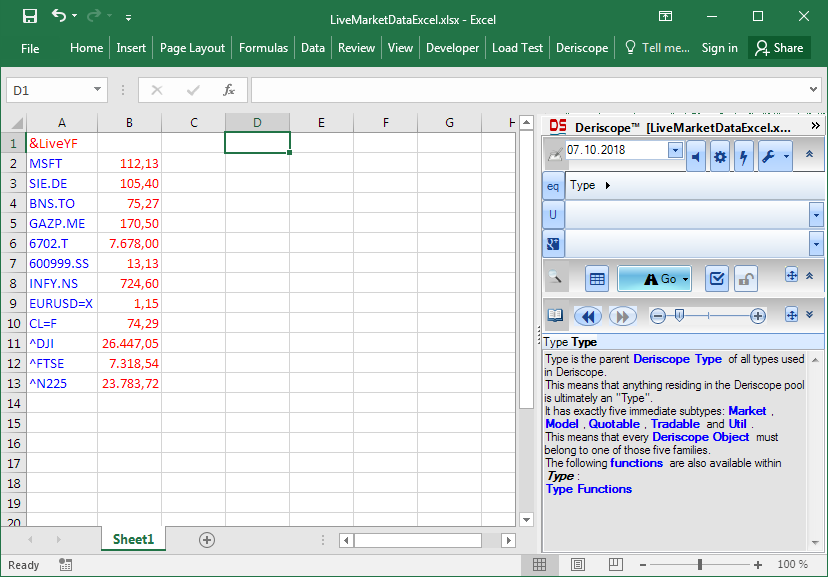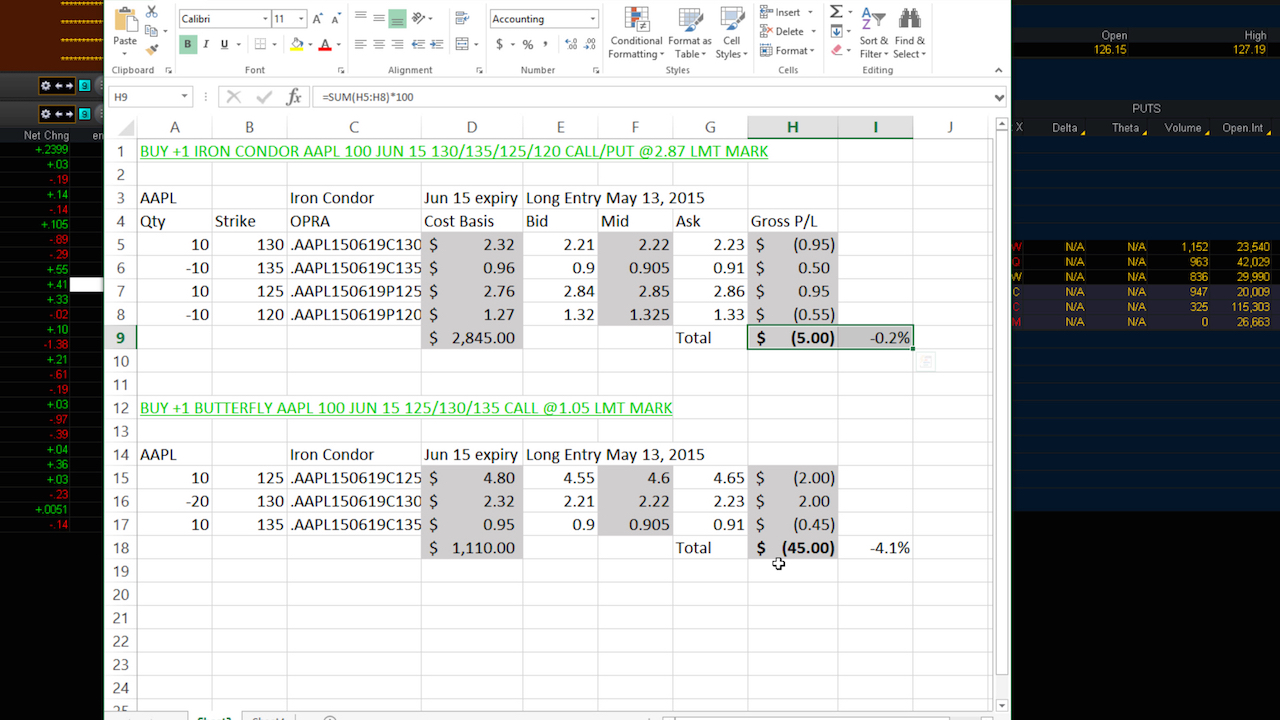Note
Office 365 ProPlus is being renamed to Microsoft 365 Apps for enterprise. For more information about this change, read this blog post.
Sep 06, 2009 Now go to your Excel file (an existing one or create a new one), choose a cell and paste (ctrl+v). You will see a bunch of #N/A’s at first, then after a few seconds the streaming will kick in. Your watchlist is now in Excel and streaming data! It will keep doing so as long as Think Desktop is open and connected to Think or Swim. Jun 14, 2015 The RTD function “pulls” data from Thinkorswim but Thinkorswim is not allowed to “push” data to Excel. Therefore Thinkorswim is not able to push a new list of ticker symbols into Excel. In order to update the list of ticker symbols in Excel you must manually export them from Thinkorswim. I have spoken with them several times and they say that while equity transactions and some other data is available for RTD connection to Excel, option time and sales data is not. However, it is there, for the viewing, and they do allow exporting as a.csv file (or web file) at any point and time so it seems more plausible than. See full list on docs.microsoft.com. Microsoft Excel provides a function called RTD (RealTimeData). This function allows for direct communications between running applications. In this situation, Excel will use RTD functions to retrieve live data from thinkorswim. Configure Excel to Retrieve RTD from TOS.
Summary
Note
The performance of the RealTimeData (RTD) function has been greatly enhanced in Excel M365 version 2002 or later. For more information, see Excel Performance and Limits Improvements.
This article describes the functionality that the RealTimeData (RTD) function provides. Microsoft Office Excel provides a worksheet function, RealTimeData (RTD). This function enables you to call a Component Object Model (COM) Automation server to retrieve data in real time.

When you have to create a workbook that includes data that is updated in real time, for example, financial data or scientific data, you can now use the RTD worksheet function. In earlier versions of Excel, Dynamic Data Exchange (DDE) is used for that purpose. The RTD function is based on COM technology and provides advantages in robustness, reliability, and convenience. RTD depends on the availability of an RTD server to make the real-time data available to Excel. For more information about how to create an RTD server, see the 'References' section.
The RTD function retrieves data from an RTD server for use in the workbook. The function result is updated whenever new data becomes available from the server and the workbook can accept it. The server waits until Excel is idle before updating. This relieves the developer of having to determine whether Excel is available to accept updates. The RTD function differs from other functions in this regard because other functions are updated only when the worksheet is recalculated.
Although the RTD function provides a link to data on a server, it is not the same type of link as references to cells in other worksheets or workbooks. For example, if you use the RTD function in a workbook, you do not receive the Links startup message when you open the workbook, nor can you manage the status of an RTD function through the Edit Links dialog box.
Syntax
The RTD function uses the following syntax

=RTD(RealTimeServerProgID,ServerName,Topic1,[Topic2], ...)
where the function arguments are as follows:
RealTimeServerProgID
A string that represents the Program ID of the RTD server installed on the local system. This is typically a COM add-in that is registered by a setup procedure or by using RegSvr32. RealTimeServerProgID is a required argument.
ServerName
A string that represents the name of the server on which the RTD server is to be run. If the RTD server is run locally, the ServerName should be an empty string (') or omitted.
Topic1, [Topic2], ...
Strings that determine the data being retrieved. You can use from one to 28 topics, although only one topic is required.
Using RTD
As an example of the RTD function, consider retrieving information from a server that delivers continuous data for runners in several simultaneous races. Assume that the server is provided as a Dynamic Link Library (DLL) named RaceReport.dll, that it is installed on the user's computer, and that it is registered as a COM add-in by its own setup process. The general form of the RTD function as used with this server might be as follows
=RTD('MyRTDServerProdID','MyServer','RaceNum','RunnerID','StatType')

where the topics RaceNum, RunnerID, and StatType determine the race of interest, the runner whose data is required, and the type of data for a particular use of the function, respectively.
Here the user might select a cell and type the following formula in it
=RTD('ExcelRTD.RaceReport',','2','16','Time')
to see the current elapsed time for runner number 16 in race number 2. The number of topics and the nature of the associated data is determined by the developer of the COM server. For example, the race-reporting server might deliver different data if you use the following RTD function:
=RTD('ExcelRTD.RaceReport',','3','25','Position')
In this case, the data returned indicates the current position of runner number 25 in race number 3.
In this manner, the same function can be used differently throughout the workbook to retrieve different data from the same server, all of which is updated automatically.
Wrappers to Simplify Use

The RTD function can be used inside user-defined functions (UDFs) in Microsoft Visual Basic for Applications. These then become wrappers for the RTD function. This approach can be useful in shielding users from the details of the RTD server name and ProgID, and in enabling them to focus only on the data that is important to them.
For example, in the previous scenario, the user might be provided with two functions: GetTime(RunnerID) and GetPosition(RunnerID). These functions assume that the user is always dealing with the same server and race number. Therefore the user only has to specify a runner's ID to receive current data on the runner's elapsed time and position, respectively.
Calculation
Because RTD updates data when Excel is idle, it continues to receive information if Excel is in manual calculation mode. In that event, the new data is cached and the current values are used when a manual calculation is performed.
Security
RTD servers should be digitally signed. If an RTD server is not digitally signed, the server may not load, and a #N/A will be displayed in the cell(s) referencing the RTD server.
For Microsoft Office Excel 2007, you can review security settings by using the Trust Center. This can be accessed by from the Trust Center tab in the Excel Options dialog box.
For Microsoft Office Excel 2003 and in Microsoft Excel 2002, the load behavior can be altered by adjusting the macro security settings in Excel.
References
Td Ameritrade
For more information about RTD and Excel security, see How to set up and use the RTD function in Excel.
Thinkorswim Download
For more information about creating an RTD server, see How to create a RealTimeData server for Excel.